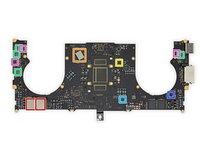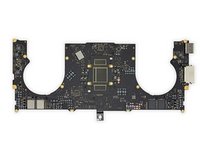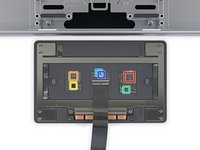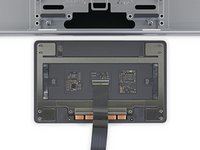Introduction
Apple introduced its M1 Pro/Max processors in the 2021 MacBook Pros. How do these new in-house SoCs change the rest of the logic board’s silicon? Check out this chip ID guide to find out!
Hats off to our community member C. Chin for contributing to this!
-
-
IC Identification, pt. 1:
-
Apple APL1103 M1 Pro system-on-a-chip (SoC)
-
Samsung K3LKYKY0EM-ZGCP 8 GB LPDDR5 SDRAM Memory (16 GB total)
-
Kioxia KICM225UZ0460 128 GB NAND Flash Memory
-
Apple APL1098/343S00515 Power Management
-
Apple 338S00600 Power Management
-
Kinetic Technologies MCDP2920 DisplayPort-to-HDMI Converter
-
Genesys Logic GL9755A Card Reader Controller
-
-
-
IC Identification, pt. 2:
-
Intel JHL8040R Thunderbolt 4 Retimer
-
Macronix MX25U6472F 64 Mb Serial NOR Flash Memory
-
Winbond W25Q80DVUXIE 8 Mb Serial NOR Flash Memory
-
Renesas RAA225701C ? Synchronous Step-Down Converter
-
Analog Devices LT86422 Synchronous Step-Down Converter
-
Texas Instruments TPS62130B Step-Down Converter
-
Texas Instruments TPS62180 6 A Synchronous Buck Converter
-
-
-
IC Identification, pt. 3:
-
Texas Instruments TVS2200 Surge Protection
-
ON Semiconductor FPF2495CUCX Load Switch
-
Texas Instruments Load Switch (likely)
-
ON Semiconductor NCV8160AMX500TBG 250 mA / 5.0 V LDO Regulator
-
Nexperia 74AVC2T45 Dual-Bit Voltage Level Translator/Transceiver
-
Texas Instruments SN74AXC1T45 Single-Bit Bus Transceiver
-
Nexperia 74AUP1G07 Single Buffer
-
-
-
IC Identification, pt. 4:
-
Texas Instruments LSF0102 2-Ch. Multi-Voltage Level Translator
-
Nexperia LSF0101 1-Bit Multi-Voltage Level Translator
-
Texas Instruments SN74AUP2G07 Dual Buffer
-
Texas Instruments SN74LVC1G07 Single Buffer
-
Nexperia 74AUP1G17 Schmitt Trigger
-
Nexperia 74AUP1G08 Single AND Gate
-
-
-
IC Identification, pt. 1:
-
Kioxia KICM225VF9081 128 GB NAND Flash Memory
-
USI 339S00912 Bluetooth/WiFi Module
-
NXP Semiconductor SN210V NFC Controller w/ Secure Element
-
Texas Instruments CD3217B12 USB Type-C Port/Power Delivery Controller
-
Renesas ISL9240 Li-Ion Battery Charger
-
Winbond W25Q80EWUXIE 8 Mb Serial NOR Flash Memory
-
Winbond W25Q80DVUXIE 8 Mb Serial NOR Flash Memory
-
-
-
-
IC Identification, pt. 2:
-
Renesas Power Phase PWM Controller
-
Cirrus Logic CS42L84A Audio Codec
-
Texas Instruments SN012776B0 Audio Amplifier
-
Texas Instruments TPS62130B Step-Down Converter
-
Renesas RAA209100 Boost Regulator (likely)
-
Texas Instruments LP8548B1 Backlight LED Driver
-
Texas Instruments TUSB2E22 USB 2.0 Dual Repeater (likely)
-
-
-
IC Identification, pt. 3:
-
Texas Instruments INA190A3 Current Sense Amplifier
-
Texas Instruments INA190A4 Current Sense Amplifier
-
Maxim Integrated MAX9620 1.5 MHz Rail-to-Rail Input/Output Operational Amplifier
-
ON Semiconductor NCS333ASQ3T2G Single Operational Amplifier
-
Dialog Semiconductor Mixed Signal Array (likely)
-
NXP Semiconductor PCAL6416A 16-Bit I/O Expander
-
Analog Devices ADG1422BCPZ Dual SPST Analog Switch
-
-
-
IC Identification, pt. 4:
-
Texas Instruments REF3325 2.5 V Voltage Reference
-
Texas Instruments TLV75801P 500 mA / Adj. LDO Regulator
-
Texas Instruments TLV75533P 500 mA / 3.3 V LDO Regulator
-
Texas Instruments LP5907SNX-3.0 250 mA / 3.0 V LDO Regulator
-
ON Semiconductor NCP163BMX180TBG 250 mA / 1.8 V LDO Regulator (likely)
-
Texas Instruments TLV70733P 200 mA / 3.3 V LDO Regulator
-
Texas Instruments TPS7A201825 200 mA / 1.825 V LDO Regulator
-
-
-
IC Identification, pt. 5:
-
Nexperia 74AVC4T774 4-Bit Translating Transceiver
-
Nexperia 74AUP1T45 Translating Tranceiver
-
Texas Instruments LSF0102 2-Ch. Multi-Voltage Level Translator
-
Nexperia LSF0101 Single-Bit Multi-Voltage Level Translator
-
Nexperia 74AVC2T45 Dual-Bit Voltage Level Translator/Transceiver
-
Texas Instruments SN74AUP1T34 Single-Bit Voltage-Level Translator
-
Texas Instruments SN74AXC1T45 Single-Bit Bus Transceiver
-
-
-
IC Identification, pt. 6:
-
Nexperia 74AXP1T34 Buffer
-
Nexperia 74AUP2G07 Dual Buffer
-
Texas Instruments SN74LVC1G07 Single Buffer
-
Nexperia 74AUP1G17 Schmitt Trigger
-
Nexperia 74LVC2G32 Dual OR Gate
-
Texas Instruments SN74AUP1G32 Single OR Gate
-
Texas Instruments TPD4S311A USB Type-C Port Protector
-
-
-
IC Identification:
-
STMicroelectronics STM32L4P5QG 32-Bit ARM Cortex-M4 Microcontroller w/ 1 MB Flash
-
Broadcom BCM5976C1 Touchpad Controller
-
Maxim Integrated MAX11390A A/D Converter (likely)
-
Monolithic Power Systems MP6519 5A H-Bridge Current Regulator
-
Texas Instruments TPS3831G18 1.67V Voltage Supply Monitor
-
Texas Instruments TPS22915 Load Switch
-
10 Guide Comments
In practise, the efficiency of an LDO regulator is dependent on how much voltage it is dropping. While operating, an LDO is effectively a resistor that varies in real-time to ensure its output voltage stays stable despite changes in load current.
Power = I (current) x V (voltage)
Since an LDO is a resistive element, yes, it burns off energy as heat in this process. So an LDO dropping 18V to 5V could be very inefficient, more so when driving a higher current load as shown by the formula above. However, if an LDO is used to generate a 3.3V rail from a 5V rail, it is dropping just 1.7V, resulting in less power dissipation for the same load current.
You’re right, using an LDO for a large voltage drop is not good electrical design. But LDOs have excellent noise rejection performance, meaning they can take a noisy rail from a switching buck/boost converter with lots of transient or high-draw components on it, and create a much cleaner rail for lower-current, more sensitive devices. This is what I expect Apple’s doing.
iEvan -
LDOs drop the difference in voltage as heat, yes - hence the voltage difference between input and output determines the efficiency (eg a 3.0v LDO fed by 6.0v is 50% efficient).
In many cases where LDOs are used in designs the amount of lost power is negligible as the current being drawn is so small - simply not worth using a switcher for that rail. Also, LDOs typically have cleaner output so often an LDO is used to isolate an analog subsystem from noise on the main (digital) system rails.
Hugo -
+ some designs will have both a switcher and an LDO for the same power rail and switch to the LDO when the current is very low. Switchers get inefficient at low currents, so having both can improve efficiency.
Dan K -





















